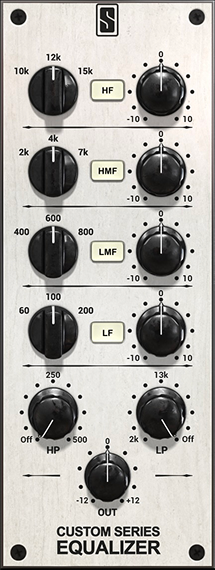CS-EQ

Shortly after the release of the Virtual Mix Rack last November, I found myself sitting in my Los Angeles studio staring at a rack of some of the industry’s finest analog equalizers. Some I had bought, some I had borrowed, some I had rented, but it didn’t matter, because on that day… they were all mine.
My objective was straightforward, but it was not easy. I was going to patch in all of the EQs and use them on a few dozen reference mixes so that I could understand which would be the most complimentary to the two classic EQ’s that we already have in the Virtual Mix Rack, the FG-N and FG-S.
But what ended up happening was way beyond what I had in mind… I started combining multiple EQ’s on various tracks to form hybrid equalization sounds that I found to be superior to any single EQ. Within a month, I had developed the concept of an EQ where every single band’s boost and cut was customized with combinations of the best analog filters so that it could be the most musical and intuitive tone shaping processor for modern audio production.
The Custom Series Equalizer was born.
Boosts
So many equalizers have the same behavior throughout their entire spectrum. The curve style and nonlinear sound of all the filter bands are clones of one another. But I began to realize that for the perfect EQ, this did not make sense. To make the most intuitive and musical equalizer that would be best suited for a wide variety of sources, the boosts would have to all be unique to their specific job and role. Each boost filter would have to be customized.
Boosting the Highs
For high end boosts, the goal is clarity, depth, and musical sheen. I noticed that I could achieve a lot of these aspects with a famous tube EQ boost on the highs. It was so smooth and lush. But then I started adding a bit of an old mastering eq on the highs to combine it with the tube eq to make a hybrid boost. This was an even more magnificent sound on both individual tracks and full mixes.
Boostings the Upper Mids
I realized that for upper mids, I wanted something broad and present that wouldn’t have the nasal and honky sound that I’d experienced in some other EQ’s. So by combining some of the upper bands of some discrete analog EQs, I made yet another unique tone that became my new standard for what an upper midrange boost should sound like.
Boosting the Low Mids
For the low mids, I found that combining another old tube EQ and a solid state American EQ gave me a boost that was warm and thick, but not too boxy. It could add body without adding mud.
Boosting the Lows
Finally, on the lows, I combined the boost of two different mastering EQs and after a week of tweaking the proportional gains and setting the ideal bandwidths, I created one of the most perfect sounding low filters I’ve ever heard. It was massive, punchy, and deep, yet focused and clear.
Cuts
After working on boosts, I began to use a transparent modern mastering EQ to experiment with cuts. My goal was to create attenuation shapes that accomplished exactly what most people are looking for when cutting frequencies, which is to remove the bad aspects of the sound that you dislike, without removing the aspects of the sound you DO like !
Cutting the Highs
For high end cuts, you want to attenuate the thinness and tinny aspects of the source, but not dull it. I was able to create a shape that could do this quite elegantly and musically.
Cutting the Upper Mids
The upper mid cut is very important, because you want to take out the honkiness and nasal sounds without losing impact and presence. Again, after a lot of work, I figured a way to accomplish this harmonious compromise.
Cutting the Low Mids and Lows
For the low mids and lows, you want to remove the boxiness but not the warmth. And for lows, you want to remove the boominess but not the body. Using customized curves, I was able to figure out the perfect method to meet these goals.
Creating the Custom Series EQ
Once I had the entire topology complete in the analog domain, the Slate Digital team and I carefully recreated the exact tonality and function of this extremely hybrid equalizer in digital form, with precise attention being paid to every musical detail. This attention was especially crucial when dealing with the range and proportions of the the hybrid filters and their unique harmonics. When all was done, I had created what many of my trusted industry colleagues are calling the ALL STAR of equalizers.
Every cut and boost is inspired by classic analog equalizers in unique proportional combinations, with a custom harmonic profile to give each band the perfect musical tone.You’re going to hear smooth and clear highs, present and punchy mids, warm low mids, and massive lows that stay focused and clear. Each band contains three fixed frequency settings, and due to the wide tonal shape of the filters, this covers a lot of ground. This is by no means a surgical EQ ! And then to top it all off, we added some extremely slick high and low pass filters.
Conclusion
Overall, the Custom Series EQ is the ultimate companion to the FG-N and FG-S. Whereas these two existing VMR EQs are strong, bold, and loaded with character, the Custom Series EQ can be more slick, cohesive, and broad. On light boosts it can sound so natural that it doesn’t sound like the track has ever been EQ’d. On stronger boosts, it can add a beautiful color and character without sounding artificial or overdone. It is truly, the All Star of equalizers!